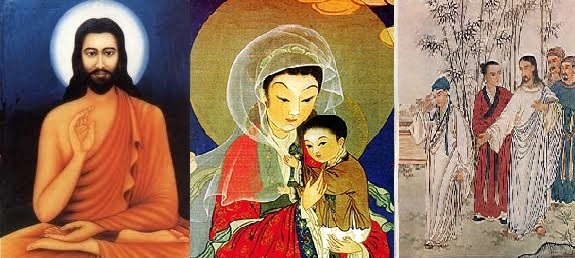 |
| http://www.theblaze.com/wp-content/uploads/2013/01/jesus-496x620.jpg |
Probably the best known and most reproduced image of Jesus is the blue-eyed, fair-haired, Aryan Jesus of Sallman Head, titled the, 'Head of Christ'. Of course, it looks nothing like the way Jesus, a Jewish man living in the First Century Middle East, would have appeared. It is an appropriation of Jesus in the service of white cultural values. This has both positive and negative aspects.
 |
| http://www.universe-people.com/english/img_0000/obr400.jpg |
https://en.wikipedia.org/wiki/Head_of_Christ
http://www.warnersallman.com/collection/images/head-of-christ/
 |
| http://thumbs.ebaystatic.com/d/l225/m/mJlHVw9-0OpTVW4ONJUS7Ew.jpg |
 |
| https://thejesusquestion.files.wordpress.com/2011/03/sallman_reproductions.jpg |
http://www.christianitytoday.com/ch/2006/issue91/11.11.html
 Of course, Jesus would not have looked anything like this. A recent documentary which had scientists perform a "forensic reconstruction" of Jesus shows a very different face. The reconstruction was created with a 2,000-year-old Jewish skull, ancient documents, and advanced software and forensic techniques to show a first-century Jewish man who would have lived in the harsh conditions of the time.
Of course, Jesus would not have looked anything like this. A recent documentary which had scientists perform a "forensic reconstruction" of Jesus shows a very different face. The reconstruction was created with a 2,000-year-old Jewish skull, ancient documents, and advanced software and forensic techniques to show a first-century Jewish man who would have lived in the harsh conditions of the time.
"Jesus certainly looked far more like that person than me and other males who live in the West," says James Charlesworth, professor of New Testament languages at Princeton Theological Seminary, one of the experts consulted in the documentary.
http://www.popularmechanics.com/science/health/a234/1282186/
http://news.discovery.com/history/art-history/what-did-jesus-look-like-131216.htm
So, why has a portrait of Jesus, that we know would look nothing like him, become so popular? I would suggest that it is for the same reason that Jesus, as a concept of God, is so popular; it makes God relateable. God is a personification of what we believe is truly legitimate, noble, powerful and worthy, Anthropomorphizing God allows us to represent these abstract qualities in a human like form that we can relate to and make our own. The image of Jesus takes that another step. Visualizing Jesus as looking like someone who is part of our own cultural and ancestral heritage group takes it even one step further. The Caucasian cultural group was dominant through most of the western world when this image was popularised. As such, visualizing him as white also conferred legitimacy and authority.http://news.discovery.com/history/art-history/what-did-jesus-look-like-131216.htm
The need to visualize God in an accessible, close to home, way is well expressed in the recent song, "One of Us", written by Eric Bazillian and popularized by Joan Osborne as the theme song for the American television series, "Joan of Arcadia",.
What if God was one of us?
Just a slob like one of us?
Just a stranger on the bus
Trying to make His way home?
 This desire to portray Jesus as part of one's own cultural/racial group is not limited to white dominant culture. Communities of colour and different ethnic heritages also portray Jesus with an appearance similar to their own. There are many portraits of a black Jesus. But they are much less prevalent in our society and can even be discouraged as sacrilegious by the dominant christian culture. I can remember an episode of the Television show, "Good Times", where the eldest son, "JJ", an aspiring ghetto artist, wants to submit a painting of a black Jesus in a local art contest. His family, who hold a copy of Sallman's white Jesus hanging on their apartment wall in reverence, find this to be scandalous.
This desire to portray Jesus as part of one's own cultural/racial group is not limited to white dominant culture. Communities of colour and different ethnic heritages also portray Jesus with an appearance similar to their own. There are many portraits of a black Jesus. But they are much less prevalent in our society and can even be discouraged as sacrilegious by the dominant christian culture. I can remember an episode of the Television show, "Good Times", where the eldest son, "JJ", an aspiring ghetto artist, wants to submit a painting of a black Jesus in a local art contest. His family, who hold a copy of Sallman's white Jesus hanging on their apartment wall in reverence, find this to be scandalous.| https://s-media-cache-ak0.pinimg.com/736x/d7/27/52/d72752c2e16f771ac86fd0f60b374d71.jpg |
 |
| http://static1.squarespace.com/static/53da8a0fe4b0d5d5360f89d8/t/53f5056ce4b0a1e4bd39bcde/1408566666489/ |
Similarly, there is current comedy on the Adult Swim segment of the Cartoon Network called, "Black Jesus", that has stirred up a lot of controversy. However, only part of the objections being voiced involve Jesus being portrayed as being black with a good part involving irreverences.

If you’re interested in seeing more Asian Jesus/Christian art, click here.
So, the 'pro' for having representations of Jesus that mirror your race and culture is that it helps one visualize God as familiar and, "one of us", relateable and personal. What are the 'cons'? One drawback is that it makes it more difficult for us to visualize those outside of our racial and cultural groups as belonging to our Christian Family. Jesus was all about a love that included, "the other", particularly those at the margin of the dominant culture. This can be seen in Jesus' words in his parable of the sheep and the goats in the twenty fifth chapter of Mathew.
The King will reply, ‘Truly I tell you, whatever you did for one of the least of these brothers and sisters of mine, you did for me.’ (Matt 25:40)
It is difficult to see someone as one of Jesus' brothers and sisters if they do not belong to the race your image of Jesus portrays. It is difficult to see Jesus in someone of a different race if your image of him is predominately 'white'.
Another 'con' is the exclusionary message it gives to members of our faith communities of different ethnic heritages. Most of us are part of faith communities that, if not multicultural, include people of differing racial heritages. Venerating an image of a 'white' Jesus tells them that what we consider is valid and legitimate is "whiteness" and that we are a Caucasian cultural group first. God, what is good, honorable, and worthy, is 'white'.
I would have to say that, in my opinion, these 'cons' outweigh the 'pro'. In a time where overt discrimination against racial minorities seems to be on the increase, particularly against those of Middle Eastern descent, I think we could use a strong image of Jesus as a Middle Eastern man of Semitic features and appearance. We need to be reminded that Jesus is the alien and the refugee that we are called on to love and include. We need to see Jesus in the, "stranger on the bus", especially if that stranger is of a different race than our own.
Another 'con' is the exclusionary message it gives to members of our faith communities of different ethnic heritages. Most of us are part of faith communities that, if not multicultural, include people of differing racial heritages. Venerating an image of a 'white' Jesus tells them that what we consider is valid and legitimate is "whiteness" and that we are a Caucasian cultural group first. God, what is good, honorable, and worthy, is 'white'.
I would have to say that, in my opinion, these 'cons' outweigh the 'pro'. In a time where overt discrimination against racial minorities seems to be on the increase, particularly against those of Middle Eastern descent, I think we could use a strong image of Jesus as a Middle Eastern man of Semitic features and appearance. We need to be reminded that Jesus is the alien and the refugee that we are called on to love and include. We need to see Jesus in the, "stranger on the bus", especially if that stranger is of a different race than our own.
 |
| http://s3.amazonaws.com/dfc_attachments/images/3287068/BlackChrist_md_web.jpg |
| http://thumbs.dreamstime.com/z/ancient-icon-black-jesus-6251845.jpg |
 |
| https://s-media-cache-ak0.pinimg.com/236x/fe/76/fd/fe76fde29ace5e2831597031dcf11b13.jpg |


You fucking bastards. Jesus was Aryan. Read Pilates description of him, or any fucking source besides “he lived in the Middle East therefore he was a dark kike”. I’m not even fucking white and this makes me sick. Jesus was Nordic. Get the fuck over it. He was a Galilean tawny skinned white man, just like his followers. Maybe his followers were black by some miracle and time travel, I don’t give a fuck. The idea that Jesus looks like a jew or Muslim is so modern that it is immediately discredited by those who care about real history and not the jew version. Give me a break, seems like you guys don’t want to worship an Aryan God? Pretty racist for a ton of faggots
ReplyDelete“I call heaven and earth to witness against you today, that I have set before you life and death, blessing and curse. Therefore choose life, that you and your offspring may live.”
ReplyDeleteDeuteronomy 30:19 ESV
“And Peter said to them, “Repent and be baptized every one of you in the name of Jesus Christ for the forgiveness of your sins, and you will receive the gift of the Holy Spirit.”
Acts 2:38 ESV
*The May 4th comment was intended as a reply to the 1st comment and not the author of this article.
ReplyDelete